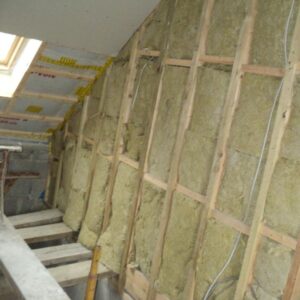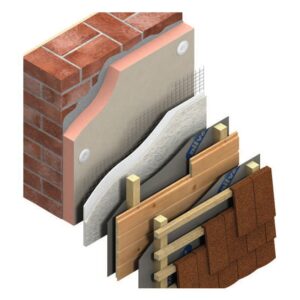Picture this:
You’ve just installed your brand-new home insulation, and you’re all excited about your energy-efficient home and saving lots on your energy bills.
But what about long-term care and maintenance?
How can you make sure your insulation slab remains in good shape for many years to come?
You’ve got the questions – we’ve got the answers!
At Roofing Superstore, we’ve put together a comprehensive guide to insulation maintenance to help you deal with all problems with external and internal wall insulation.
Let’s dive in.
Table of contents:
- What is the lifespan of insulation?
- How to maintain internal wall insulation
- How to maintain external wall insulation
- Final thoughts
What is the lifespan of insulation?
One of the first things homeowners like to know is how long they can expect their insulation to last.
But because there are so many different types of insulation – boards, slabs, roll, multifoil, to mention just a few – the quick answer is that the lifespan generally depends on which type you have.
Here’s the deal:

Fibreglass can last between 80 and 100 years as long as it remains undamaged. Likewise, spray foam is extremely durable, as is mineral wool.
At the other end of the spectrum, cellulose might potentially start to degrade around 25 to 30 years.
The key takeaway is:
Most insulation options available on the market can easily last a lifetime.
So, what can you do to ensure such longevity?
That’s what we’re going to zoom in on next.
How to maintain internal wall insulation
In industrial settings, most systems are designed with clearly marked inspection locations, which allow for minimum intrusion.
However, that’s rarely the case in domestic settings.
The good news is:
Cavity wall insulation is maintenance-free if fitted properly.
When it comes to loft insulation, though, you need to keep an eye on roof leaks. If left unchecked, these will wreak havoc on your insulation as well as on your ceiling.
And that’s the last thing you need.
Condensation will have a similar effect, which is why you should maintain a steady temperature during colder months.
How to maintain external wall insulation

When it comes to general maintenance of outside house insulation, the same rules apply as with internal insulation.
To begin with, avoid condensation at all costs. In addition, allow air to circulate around your home by opening the windows on a regular basis.
If you need to add any external wall insulation fixings, they need to be long enough to go through the insulation and reach the wall. The recommended minimum length of a fixing to an external wall insulation is 110 millimetres.
Next:
Use a soft bristled brush to remove any stains. Be careful not to brush too hard so as not to damage the specialist render.
How about mould, mildew and algae?
Unfortunately, these microorganisms might grow even on your external wall insulation. An easy way to remove them is by applying a solution of diluted bleach – one part bleach to four or five parts clean, lukewarm water is your best bet. Once again, use a soft brush and rinse the wall thoroughly after application.
Keep in mind that even ladders which come with protected ends could potentially damage the external wall insulation render or leave unwanted marks. To prevent this from happening, make sure you spread the load on the surface with a batten wrapped in a large cloth.
When it comes to long-term maintenance of your external house insulation, it’s a good idea to check how weathertight your windows are. In addition, pay special attention to any areas where the render might be penetrated, such as a boiler flue outlet.
Last but certainly not least:
Inspect the rainwater system for any blockages or leakages.
Final thoughts
Home insulation is a great long-term investment that will pay handsome dividends for many decades.
While it’s highly durable, most problems with external or internal wall insulation come from negligence.
Luckily, that’s something you can easily fix.
The bottom line is:
Prevent leaks, condensation and blockages, clean stains promptly and use ladders carefully – and you’ll have nothing to worry about.











